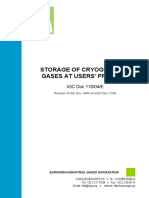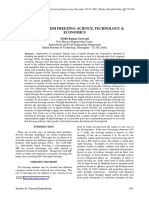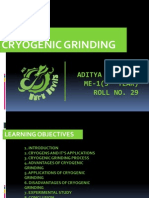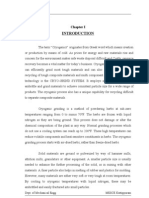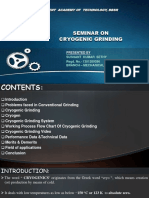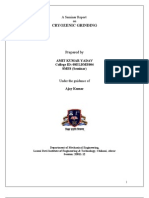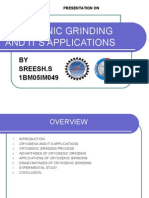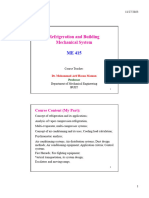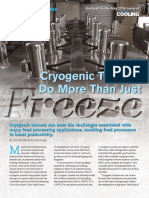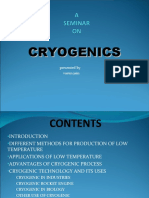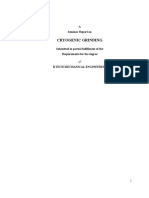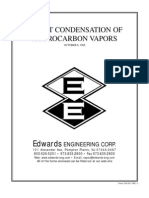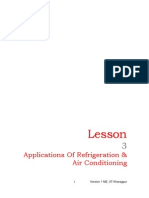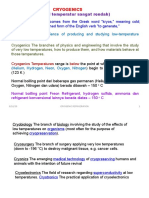Cryogenic Freezing Technology: Yogesh Kumar, Soumitra Tiwari and Yashwant Kumar
Cryogenic Freezing Technology: Yogesh Kumar, Soumitra Tiwari and Yashwant Kumar
Uploaded by
Aditya DiwediCopyright:
Available Formats
Cryogenic Freezing Technology: Yogesh Kumar, Soumitra Tiwari and Yashwant Kumar
Cryogenic Freezing Technology: Yogesh Kumar, Soumitra Tiwari and Yashwant Kumar
Uploaded by
Aditya DiwediOriginal Title
Copyright
Available Formats
Share this document
Did you find this document useful?
Is this content inappropriate?
Copyright:
Available Formats
Cryogenic Freezing Technology: Yogesh Kumar, Soumitra Tiwari and Yashwant Kumar
Cryogenic Freezing Technology: Yogesh Kumar, Soumitra Tiwari and Yashwant Kumar
Uploaded by
Aditya DiwediCopyright:
Available Formats
Available online at www.ijpab.
com
Kumar et al Int. J. Pure App. Biosci. 6 (2): 1343-1346 (2018) ISSN: 2320 – 7051
DOI: http://dx.doi.org/10.18782/2320-7051.6458 ISSN: 2320 – 7051
Int. J. Pure App. Biosci. 6 (2): 1343-1346 (2018)
Short Communication
Cryogenic Freezing Technology
Yogesh Kumar1*, Soumitra Tiwari2 and Yashwant Kumar2
1
Lecturer, Department of Food Processing &Technology, Bilaspur University, C.G., India
2
Assistant Professor, Department of Food Processing &Technology, Bilaspur University, C.G., India
*Corresponding Author E-mail: pintuyogesh321@gmail.com
Received: 18.03.2018 | Revised: 23.04.2018 | Accepted: 27.04.2018
ABSTRACT
We are living in 21 centuries and this time is totally based upon technology. In food processing
sector many technology are used for many purpose. Cryogenic freezing technology is come and
change the preservation process by which any living cells, tissues and food products are
protected from spoilage or de cay by preserved them at very low temperature. In this technology
all type of moisture are removed from the food product and make solid. When liquid N2 or Co2
(Cryogenic liquid) comes into contact with product it convert the phase from liquid to vapor with
the help of Heat transfer. Boiling point of liquid nitrogen of -196 degree c. liquid nitrogen is
converting from liquid to vapor at that low temp.
Key word: Cryogenic freezing, Liquid nitrogen, Liquid carbon dioxide, Heat transfer, Low
temperature.
INTRODUCTION According to NIST (National Institute of
Cryogenic technologies give low temperature Standard and Technology, US)1. Cryogenic is
application in food sectors. Cryogenic the science that address the production and
technologies are generally used for food effects of very low temperature. The word
processing and food preservation many originates from the Greek words “Kryos”
industry are use cryogenic technology in this meaning “Frost” and “Genic” meaning “to
time for batter food quality and good products. produce” under the user definition it could be
Cryogenic may be defined as the branch of used to include all temperature below the
physics and engineering which deals with the freezing paint or water (oC).
production of freezing “cold” and the study of
material at such low temperatures.
Cite this article: Kumar, Y., Tiwari, S. and Kumar, Y., Cryogenic Freezing Technology, Int. J. Pure App.
Biosci. 6(2): 1343-1346 (2018). doi: http://dx.doi.org/10.18782/2320-7051.6458
Copyright © March-April, 2018; IJPAB 1343
Kumar et al Int. J. Pure App. Biosci. 6 (2): 1343-1346 (2018) ISSN: 2320 – 7051
Some thermo physical prosperity of liquid nitrogen and liquid carbon dioxide are given in below table –
Table – some thermo physical prosperity of liquid nitrogen and liquid carbon dioxide [3]
Property LN2 LCO2
Density 808 464
Boiling point -196 -78.5
Thermal conductivity 0.14 0.19
Specific heat of liquid .05 2.26
Latent heat of evaporation 199 352
According to Balasubramanian et al.5, reported freezes the products.) Cryogenic freezers, on
that Cryogenics has numerous applications in the other hand are direct cooling systems.
space science, electronics, automobiles, the Where cold liquidized food grade gases are
manufacturing industry, sports and musical directly sprayed onto the product. These gases
instruments, biological science and agriculture, are liquid nitrogen and liquid Co2 or solid Co2
etc. Cryogenic freezing finds pivotal mechanical or blast freezer work with a
application in food, that is, spices and controlled temperature range between - 35 to -
condiments. 40 degrees cryogenic freezers can reach
According to Kadam6, The process significantly lower temperature. With liquid
results in production of fine particles with a nitrogen you can work in range of -60 to -120
high level of quality. In addition, process degrees and with liquid Co2in ranges of -40 to
volumes increase significantly. During the -60 degrees. The significantly lower
grinding process heat sensitive materials are temperatures lead to higher freezing speed and
cooled with cryogenic gases inorder to protect much smaller ice crystals within the frozen
them from increase in temperature resulting product. The smaller ice crystals result in a
from the heat generated by the process. This better product quality compared to common
means that it is impossible for the powdered mechanical or blast freezers.
material to melt or become sticky. Cryogenics is the cooling of materials
According to Tridib Kumar Goswami7 to extremely low temperature using highly
studied that processing or preservation condensed gases. Cryogenics in volves
techniques to enhance the storage life. refrigeration at temp below 120K (-153oc).
Cryogenics is a branch of engineering wherein Cryogenic temperatures are generally achieved
production of cryogen and the maintenance of through a refrigeration cycle2.
low temperature technologies are studied. its Type of Cryogenics freezer:-
also used for batter transportation for material. A. Cabinet freezer
Studied that one of the main limitations B. Tunnel freezer
of the conventional grinding process is the C. Spraying freezer
thermal damage. One of the feasible methods D. Immersion Freezer
to control the thermal damages is to perform A. Cabinet freezer -
grinding or comminution under controlled Frozen capacity - 500kg/h
temperature conditions. Hence, it is especially Lowest Temp. - 150oc
important to perform the grinding at reduced Maximum cooling rate - > 20oc/min
temperatures8. B. Tunnel Freezer –
Cryogenic freezing is an upcoming food Frozen capacity - 300kg/h
processing technology that is ganing Lowest Temp. - 100oc
popularity because of the lower setup casts and Maximum cooling rate - > 20oc/min
improved food quality when comped to C. Spraying - Liquid N or Co2 sprayed on the
mechanical freezing. Cryogenic food freezing food product.
differs widely from mechanical ammonia of D. Immersion- Food Product is immersion
freon freezing systems. Mechanical freezers the bath container.
also known as blast freezers are indirect Immersion cryogenic freezing use tunnel
cooling. Where a refrigerant cools down the through which passes a constant-speed
air surrounding the products (Which then horizontal conveyor belt. Which is based on
Copyright © March-April, 2018; IJPAB 1344
Kumar et al Int. J. Pure App. Biosci. 6 (2): 1343-1346 (2018) ISSN: 2320 – 7051
pulley. The unpackaged food product is exposing the product. The food product is
placed on the horizontal belt and freezing freeze with the help of liquid N and CO2.
is achieved by immersion cryogenic liquid There are convert the face with the help of
refrigerant to dip on the product or by heat transfer.
Fig. 1: Simple illustration of a typical immersion freezer
Fig. 2: Simple illustration of a typical immersion freezer
Application of these cryogens freezing in Biological laboratory: - Quick freeze the
different aspects of food processing and samples.
preservation opens a new era of refrigeration. Grinding Technology for Spices
Like every operation has some advantage and Processing
disadvantage, cryogenic freezing application Advantage –
also has no exceptions. 1. Low Investment cost
Application- 2. Very low dehydration
Our liquid nitrogen freezers have been widely
Disadvantage-
used in quick freezing of:-
1. In tunnel freezer use belts. There are uses
Food Packaging in industry
bearing for move the product due to cold
Seafood and meat: - Fish, Shrimp,
environment. it are subject to significant
Lobster, Squid, Sea Cucumber,
maintenance.
especially those high valued sea
2. High Consumption of N and Co2
food, Beef, Chicken, Pork, Mutton etc.
3. Floors are damage from leaking
Fruits and vegetable: - Durian,
refrigerant.
strawberry, Dragon Fruit, Broccoli,
Beans etc. 4. Long Contractual period.
Fast food: - Hamburger, cake, Shrimp
rings, Squid, Rings etc.
Copyright © March-April, 2018; IJPAB 1345
Kumar et al Int. J. Pure App. Biosci. 6 (2): 1343-1346 (2018) ISSN: 2320 – 7051
REFERENCES grinding: a review.; 52(9): 781-94.
1. https://www.nist.gov/mml/acmd/cryogenic doi:10.1080/10408398.2010.509552
-technologies-project/about-cryogenics (2012).
2. http://encyclopedia.che.engin.umich.edu/P 6. Kadam, D. M., Cryogenic Grinding
ages/HeatTransfer/Cryogenics/Cryogenics. Technology for Spices Processing, Spices
html Handbook (2015).
3. http://www.iuac.res.in/reres/cryo/icc/DST 7. Goswami, T. K., Role of Cryogenics in
Report(Final).pdf Food Processing and Preservation,
4. Barnwal, P. and Singh, K., Application of International Journal of Food
cryogenic technology in food processing Engineering, DOI: https://doi.org/
and preservation, National Seminar on 10.2202/1556-3758.1771 (2010).
Engineering Interventions for Global 8. Malkin, S., Guo, C., Thermal Analysis of
Competitiveness of Indian Dairy Industry Grinding. Annals of the CIRP Connecticut,
(2014). USA (2007).
5. Balasubramanian, S. I., Gupta, M. K., 9. Fellows, P., Food processing technology:
Singh, K. K., Cryogenics and its principles and practice (2017).
application with reference to spice
Copyright © March-April, 2018; IJPAB 1346
You might also like
- Basis of Design LNGDocument148 pagesBasis of Design LNGCal84% (25)
- Timmerhaus - Cryogenic Process EngineeringDocument24 pagesTimmerhaus - Cryogenic Process EngineeringMaria Andreina MontañezNo ratings yet
- As 2683-2000 Hose and Hose Assemblies For Distribution of Petroleum and Petroleum Products (Excepting LPG)Document7 pagesAs 2683-2000 Hose and Hose Assemblies For Distribution of Petroleum and Petroleum Products (Excepting LPG)SAI Global - APACNo ratings yet
- EIGA 115-04 Condiciones en Instalaciones de ClientesDocument24 pagesEIGA 115-04 Condiciones en Instalaciones de ClientesdmpresasNo ratings yet
- Cryogenic Fish Freezing: Science, Technology & EconomicsDocument6 pagesCryogenic Fish Freezing: Science, Technology & EconomicsSangita MaityNo ratings yet
- CRYOGENICS GrindingDocument18 pagesCRYOGENICS GrindingAditya AggarwalNo ratings yet
- Seminar Report ShailendraDocument20 pagesSeminar Report ShailendraShailendra Singh0% (1)
- Cryogenic GrindingDocument23 pagesCryogenic Grindingaditya svNo ratings yet
- Raj - Cryo FINALDocument23 pagesRaj - Cryo FINALRajesh BeheraNo ratings yet
- Extremely Low-Temperature SystemsDocument7 pagesExtremely Low-Temperature SystemsArath RomeroNo ratings yet
- Cryogenic GrindingDocument24 pagesCryogenic GrindingV P SinghNo ratings yet
- Cryogenic GrindingDocument34 pagesCryogenic GrindingShajahan Kanniyamuku ParambilNo ratings yet
- Cryogenic Application in Food IndustryDocument14 pagesCryogenic Application in Food IndustrySiva KumarNo ratings yet
- Food Processingand PreservationDocument15 pagesFood Processingand Preservationmahmodalali811999No ratings yet
- AJAPAS-4-2022-004Document12 pagesAJAPAS-4-2022-004BudNo ratings yet
- Refrigeration EngineeringDocument5 pagesRefrigeration EngineeringabelegenicaNo ratings yet
- Cryogenic GrindingDocument22 pagesCryogenic GrindingSyed RizwanNo ratings yet
- Application of Phase Change Materials in Refrigerator and Freezer Appliances A Comprehensive ReviewDocument19 pagesApplication of Phase Change Materials in Refrigerator and Freezer Appliances A Comprehensive ReviewAndre spurvonovNo ratings yet
- I JC A Performance Evaluation of Vapour Compression CycleDocument5 pagesI JC A Performance Evaluation of Vapour Compression CycleErnaNo ratings yet
- Cryogenic GrindingDocument3 pagesCryogenic GrindingDondon IrigNo ratings yet
- Agnelli Mascheroni JFoodEng 522002257 263Document8 pagesAgnelli Mascheroni JFoodEng 522002257 263Nguyen Minh TrongNo ratings yet
- Seminar On Cryogenic Grinding: Trident Academy of Technology, BBSRDocument19 pagesSeminar On Cryogenic Grinding: Trident Academy of Technology, BBSRPrashant JondhaleNo ratings yet
- Refrigeration and Air ConditioningDocument11 pagesRefrigeration and Air ConditioningRavikumar TNo ratings yet
- Mee 431 L-1&2Document81 pagesMee 431 L-1&2ফারহান আহমেদ আবীরNo ratings yet
- Cryogenic GrindingDocument23 pagesCryogenic Grindingsuresh100% (1)
- Engineering Mechanics Unit-3Document31 pagesEngineering Mechanics Unit-3ZeeshanNo ratings yet
- Cryogenic GrindingDocument21 pagesCryogenic GrindingRahul Yadav100% (1)
- Dr. Vijaya Khader Dr. MC Varadaraj: Development TeamDocument9 pagesDr. Vijaya Khader Dr. MC Varadaraj: Development TeamKanchanNo ratings yet
- Cryogenic Grinding and It'S Applications: BY Sreesh.S 1BM05IM049Document16 pagesCryogenic Grinding and It'S Applications: BY Sreesh.S 1BM05IM049Shrikantha HsNo ratings yet
- AbcdDocument3 pagesAbcdRahul SinhaNo ratings yet
- Role of IT in The Innovation of CryogenicsDocument3 pagesRole of IT in The Innovation of CryogenicsMaryjoy JanaNo ratings yet
- Lecture - Notes RAC UNIT 1Document10 pagesLecture - Notes RAC UNIT 1prvaeenkumar228No ratings yet
- Module-I Air Refrigeration: Subject Code: FOOD315 Subject Name: Food Engineering-IIDocument6 pagesModule-I Air Refrigeration: Subject Code: FOOD315 Subject Name: Food Engineering-IIShubham MannaNo ratings yet
- Refrigeration System Using Nano Fluid: A Review ArticleDocument5 pagesRefrigeration System Using Nano Fluid: A Review ArticleFavour AdenugbaNo ratings yet
- Seminar Report On Magnetic RefrigerationDocument24 pagesSeminar Report On Magnetic Refrigerationsanjay dev50% (2)
- Refrizaration Lecture 1 2023Document31 pagesRefrizaration Lecture 1 2023uchihaenomiNo ratings yet
- En Cryogenic Tunnel Freezers Do More Then FreezeDocument4 pagesEn Cryogenic Tunnel Freezers Do More Then Freezesamekh80No ratings yet
- Presentation Transcript: PROJECT 2009Document14 pagesPresentation Transcript: PROJECT 2009Prashant KumarNo ratings yet
- Design of A Cryogenic Grinding System For SpicesDocument10 pagesDesign of A Cryogenic Grinding System For Spicesdeepakkumar2626No ratings yet
- Cryoking Biologix Low Temperature Storage SystemDocument25 pagesCryoking Biologix Low Temperature Storage SystemJeison Steven Dejesus CastilloNo ratings yet
- Refrigeration and Air ConditioningDocument33 pagesRefrigeration and Air ConditioninghermelaNo ratings yet
- Selvaraj-Victor2021 Article VapourAbsorptionRefrigerationSDocument11 pagesSelvaraj-Victor2021 Article VapourAbsorptionRefrigerationSWillem van der WaltNo ratings yet
- VarunDocument21 pagesVarunvarunNo ratings yet
- Refrigeration Systems: Ice Refrigeration and Product Load RefrigerationDocument14 pagesRefrigeration Systems: Ice Refrigeration and Product Load RefrigerationCllyan Reyes100% (1)
- Refrigeration & Air ConditioningDocument15 pagesRefrigeration & Air Conditioningmsahi2558No ratings yet
- Cryogenics & Application OF Cryogenics As Rocket PropellantsDocument10 pagesCryogenics & Application OF Cryogenics As Rocket PropellantsNagaraj VukkadapuNo ratings yet
- Application of R&ACDocument37 pagesApplication of R&ACsineNo ratings yet
- A Technical Seminar ON Cryogenic CoolingDocument16 pagesA Technical Seminar ON Cryogenic CoolingrishipareekNo ratings yet
- A Technical Seminar ON Cryogenic CoolingDocument16 pagesA Technical Seminar ON Cryogenic CoolingrishipareekNo ratings yet
- R&ac Unit-1Document27 pagesR&ac Unit-1Dinesh ManikantaNo ratings yet
- CryogeniDocument17 pagesCryogenirishipareekNo ratings yet
- Cryogenic CoolingDocument17 pagesCryogenic Coolingrishipareek0% (1)
- 1 s2.0 S0360319923053132 MainDocument14 pages1 s2.0 S0360319923053132 MainFlames ShoppingNo ratings yet
- Thermal Diffusivity Variations of Food Products in Natural Convection CoolingDocument7 pagesThermal Diffusivity Variations of Food Products in Natural Convection CoolingDANIELLY LOPES DE OLIVEIRANo ratings yet
- Lecture 1 Air Conditioning and RefrigrationDocument15 pagesLecture 1 Air Conditioning and RefrigrationWaris Ali BozdarNo ratings yet
- R and AC Presentation - 1Document39 pagesR and AC Presentation - 1teddiyfentawNo ratings yet
- 3rd Seminar (Gokul)Document16 pages3rd Seminar (Gokul)keerthika9543No ratings yet
- Cryogenic GrindingDocument30 pagesCryogenic GrindingVIBHOR BANSALNo ratings yet
- Ejectors for Efficient Refrigeration: Design, Applications and Computational Fluid DynamicsFrom EverandEjectors for Efficient Refrigeration: Design, Applications and Computational Fluid DynamicsNo ratings yet
- Pumps 2Document1 pagePumps 2Ahmad DeyabNo ratings yet
- Process Operator Experience 08 Years Muhammad Faisal: Details of Experience at LNG Plant Ras GasDocument3 pagesProcess Operator Experience 08 Years Muhammad Faisal: Details of Experience at LNG Plant Ras GasMuhammad Hamza NaveedNo ratings yet
- Cryogenic Theory and ApplicationsDocument29 pagesCryogenic Theory and ApplicationsMalu_Julienne__5233No ratings yet
- A Hermetic On-Cryostat Helium Source For Low Temperature ExperimentsDocument5 pagesA Hermetic On-Cryostat Helium Source For Low Temperature ExperimentsadsdasdassadsadNo ratings yet
- M C 12 - 01 - MarineLoadingArms - EDocument6 pagesM C 12 - 01 - MarineLoadingArms - Etuananh.1216fNo ratings yet
- Bcga Code of Practice CP 22: Bulk Liquid Argon or Nitrogen Storage at Production SitesDocument45 pagesBcga Code of Practice CP 22: Bulk Liquid Argon or Nitrogen Storage at Production SiteszhangjieNo ratings yet
- Full Text 01Document51 pagesFull Text 01irinaNo ratings yet
- CHART Liquid Cylinder Product ManualDocument62 pagesCHART Liquid Cylinder Product ManualTrung Hiếu CamNo ratings yet
- Catalog 1087 ENDocument79 pagesCatalog 1087 ENsergeh711No ratings yet
- Flashing Liquid Expanders For Crygenic IndustriesDocument18 pagesFlashing Liquid Expanders For Crygenic IndustriesPeter PerezNo ratings yet
- Direct Condensation of Hydrocarbon VaporsDocument10 pagesDirect Condensation of Hydrocarbon VaporsManju Lata Kapur100% (1)
- Q Gca Get StartedDocument42 pagesQ Gca Get StartedWilson PiresNo ratings yet
- AAV ThermaxDocument2 pagesAAV Thermax123habib123fikriNo ratings yet
- SuperconductorsDocument19 pagesSuperconductorskailonNo ratings yet
- Cryogenic PipingDocument34 pagesCryogenic PipingDilip100% (4)
- EIGA - Operation of Static Cryogenic VesselsDocument14 pagesEIGA - Operation of Static Cryogenic Vesselspablopasqualini18No ratings yet
- Brochure PDFDocument16 pagesBrochure PDFVipal Patel100% (1)
- Rac3 10Document127 pagesRac3 10aisreen100% (1)
- Valves in LNG ServiceDocument4 pagesValves in LNG ServicePasquale CutriNo ratings yet
- Design and Fabrication of Pulse Tube Refrigeration SystemDocument43 pagesDesign and Fabrication of Pulse Tube Refrigeration SystemDeepak HingoleNo ratings yet
- Engine Builder February 2018Document60 pagesEngine Builder February 2018Gord IsaacsonNo ratings yet
- Success of BCS TheoryDocument3 pagesSuccess of BCS TheorySobuj RajNo ratings yet
- Refrigerants Classification TypesDocument17 pagesRefrigerants Classification TypesermiasNo ratings yet
- Cryogenic Refrigeration Lec - 1Document45 pagesCryogenic Refrigeration Lec - 1bagiyo condroNo ratings yet
- DFINITI Electric Heater BrochureDocument12 pagesDFINITI Electric Heater BrochurePillai S KumarNo ratings yet
- Thermax PDS1.0Document2 pagesThermax PDS1.0John SAUERNo ratings yet



